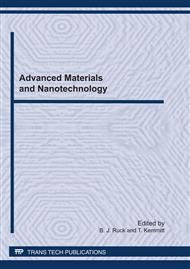[1]
S. Iijima, Helical microtubules of graphitic carbon, Nature 354 (1991) 56-58.
DOI: 10.1038/354056a0
Google Scholar
[2]
W. Z. Li, S. S. Xie, L. X. Qian, B. H. Chang, B. S. Zou, W. Y. Zhou, R. A. Zhao and G. Wang, Large-scale synthesis of aligned carbon nanotubes, Science, 274 (1996) 1701-1703.
DOI: 10.1126/science.274.5293.1701
Google Scholar
[3]
Y. Y. Zhang, Y. Shi, F. Chen, S. G. Mhaisalkar, L. J. Li, B. S. Ong and Y. Wu, Poly (3, 3 -didodecylquarterthiophene) field effect transistors with single-walled carbon nanotube based source and drain electrodes, Appl. Phys. Lett. 91 (2007).
DOI: 10.1063/1.2806234
Google Scholar
[4]
M. J. O'connell et al., Band Gap Fluorescence from Individual Single-Walled Carbon Nanotubes, Science 297 (2002) 593-596.
Google Scholar
[5]
S. M. Bachilo et al., Structure-Assigned Optical Spectra of Single-Walled Carbon Nanotubes, Science 298 (2002) 2361-2366.
DOI: 10.1126/science.1078727
Google Scholar
[6]
J. Lefebvre, Y. Homma, and P. Finnie, Bright Band Gap Photoluminescence from Unprocessed Single-Walled Carbon Nanotubes, Phys. Rev. Lett. 90 (2003) 217401-217404.
DOI: 10.1103/physrevlett.90.217401
Google Scholar
[7]
D. Yu, Y. Chen, B. Li, X. Chen and M. Zhang, Fabrication and characterization of PbS/multiwalled carbon nanotube heterostructures, Appl. Phys. Lett. 90 (2007) 161103e1-161103e3.
DOI: 10.1063/1.2723651
Google Scholar
[8]
G. Hu, M. Cheng, D. Ma, and X. Bao, Synthesis of carbon nanotube bundles with mesoporous structure by a self-assembly solvothermal route, Chem. Mater 15 (2003) 1470-1473.
DOI: 10.1021/cm0209362
Google Scholar
[9]
W. D. Zhang, Y. Wen, S. M. Liu, W. C. Tjiu, G. Q. Xu and L. M. Gan, Synthesis of vertically aligned carbon nanotubes on metal deposited quartz plates, Carbon, 40 (2002) 1981-(1989).
DOI: 10.1016/s0008-6223(02)00052-0
Google Scholar
[10]
Q. Li, H. Yan, J. Zhang and Z. Liu, Effect of hydrocarbons precursors on the formation of carbon nanotubes in chemical vapor deposition, Carbon, 42 (2004) 829-835.
DOI: 10.1016/j.carbon.2004.01.070
Google Scholar
[11]
Y. Kawashima and G. Katagiri, Observation of the out-of-plane mode in the Raman scattering from the graphite edge plane, Phys. Rev. B59 (1999) 62-64.
DOI: 10.1103/physrevb.59.62
Google Scholar
[12]
A. Kasuya, Y. Sasaki, Y. Saito, K. Kohji and Y. Nishina, Evidence for Size-Dependent Discrete Dispersions in Single-Wall Nanotubes, Phys. Rev. Lett. 78 (1997) 4434-4437.
DOI: 10.1103/physrevlett.78.4434
Google Scholar
[13]
A. M. Rao, S. Bandow, E. Richter and P. C. Eklund, Raman spectroscopy of pristine and doped single wall carbon nanotubes, Thin Solid Films, 331 (1998) 141-147.
DOI: 10.1016/s0040-6090(98)00910-9
Google Scholar
[14]
D. Karaiskaj, C. Engtrakul, T. McDonald, M. J. Heben and A. Mascarenhas, Intrinsic and Extrinsic Effects in the Temperature-Dependent Photoluminescence of Semiconducting Carbon Nanotubes, Phys. Rev. Lett. 96 (2006) 106805-106809.
DOI: 10.1103/physrevlett.96.106805
Google Scholar
[15]
L. –J. Li, R. J. Nicholas, R. S. Deacon and P. A. Shields, Chirality Assignment of Single-Walled Carbon Nanotubes with Strain , Phys. Rev. Lett. 93 (2004) 156104-156107.
DOI: 10.1103/physrevlett.93.156104
Google Scholar
[16]
L. Yang and J. Han, Electronic Structure of Deformed Carbon Nanotubes, Phys. Rev. Lett. 85 (2000) 154-157.
DOI: 10.1103/physrevlett.85.154
Google Scholar
[17]
L . Yang, M. P. Anantram, J. Han and J. P. Lu, Band-gap change of carbon nanotubes: Effect of small uniaxial and torsional strain, Phys. Rev. B60 (1999) 13874-13878.
DOI: 10.1103/physrevb.60.13874
Google Scholar
[18]
K. Matsuda, Y. Kanemitsu, K. Irie, T. Sqiki, T. Someya, Y. Miyauchi and S. Maruyama, Photoluminescence intermittency in an individual single-walled carbon nanotube at room temperature, Appl. Phys. Lett. 86 (2005) 123116-123118.
DOI: 10.1063/1.1894609
Google Scholar
[19]
M. Liao, Z. Feng, S. Yang, C. Chai, Z. Liu, J. Yang and Z. Wang, Anomalous temperature dependence of photoluminescence from a-C: H film deposited by energetic hydrocarbon ion beam, Solid State Comm., 121 (2002) 287-290.
DOI: 10.1016/s0038-1098(01)00489-6
Google Scholar
[20]
J. Guo, C. Yang, Z. M. Li, M. Bai, H. J. Liu, G. D. Li, E. G. Wang, C. T. Chan, Z. K. Tang, W. K. Ge and X. Xiao, Efficient visible photoluminescence from carbon nanotubes in zeolite templates, Phys. Rev. Lett. 93 (2004) 017402e1-017402e4.
DOI: 10.1103/physrevlett.93.017402
Google Scholar
[21]
D. Karaiskaj, C. Engtrakul, T. McDonald, M. J. Heben and A. Mascarenhas, Intrinsic and extrinsic effects in the temperature-dependent photoluminescence of semiconducting carbon nanotubes, Phys. Rev. Lett. 96 (2006) 106805e1-106805e4.
DOI: 10.1103/physrevlett.96.106805
Google Scholar


